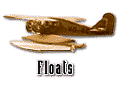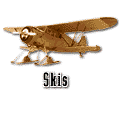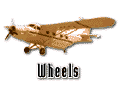

By the late 1930's half of the Canadian mail was carried by bush planes to points in Northwestern Ontario and Central Manitoba's mining district. Miners quickly realized the advantages of aircraft in the search of new mines. Areas from Great Bear Lake, Northwest Territories to Chibougamau, Quebec, were dependent upon air transport. Growing interest in mineral exploration and development in the interwar years made commercial flying into the North a profitable enterprise. Having interchangeable landing gear was necessary to enable the pilots to land their planes on any type of terrain they encountered in these new areas.
Click the icons (left) to see landing gear examples or on Model List for specific model types.

Floats were sealed metal-based devices used to land on water. They had to be of standard, balanced weight and length according to the proportion of the aircraft. Floats were interchangeable with other landing gear like skis and wheels. These planes usually had a canoe and paddle tied down so that cargo and equipment could be brought to shore easily without getting wet.

Skis were made of wood and had extra cables to ensure the front tips were pointing upward. Winter flying introduced a new set of hazards because, at times, aircraft had to land in a combination of deep snow, slush and water. This meant hours of hard slugging, jacking up the aircraft and cutting logs in the bush then dragging them back to the machine and working them under the skis.

The most common type of landing gear were wheels. The tires required a standard amount of air pressure. Not knowing what the pilots were going to land on made trips up north dangerous. Occasionally, aircraft had to land on a combination of terrain. As one pilot put it, "The really tricky stuff was an old forest burn with trees sticking up like spears".

 |  |  |  |

